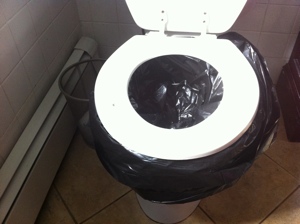
Researched in August, 2016
The information from a seminar I attended given by a representative of a state disaster agency, was sobering.
Unlike other challenges in being prepared for disasters, it's impossible to defend oneself against the disease and plagues that will inevitably arise from our various grids being down on which our sanitation services are dependent unless you have quasi-full community buy-in. This means a huge majority of neighbors accepting to do what must be done to keep the problems that contribute to the total break-down in sanitation from occurring. It would not take very many refusing to behave responsibly to bring disaster down upon the whole neighborhood. One home overrun by vermin would become an insurmountable problem for the surrounding homes.
There is nothing alarmist, overdone or fuzzy at all in my mind as I thought and continue to think hard about the information presented and other information I've uncovered on-line.
On the upside, preparing for and preventing the community health disaster that poor sanitation brings is much less expensive and mysterious than other preparedness topics. What's needed is easily quantifiable, not too open-ended and easily within the grasp of most to understand. The work to prepare is comparatively minimal and the activation of a sanitation plan isn't much more than one would have to engage in when the time came anyway. It's almost the case that doing it right is not much more trouble than doing it wrong or stupidly.
One reason to communicate this is to promote the need for local, community disaster-preparedness committees. Your neighborhood may not even have such a thing. If not, you may wish to step up and organize one. It's a huge, exhausting and richly unrewarding job, but one that will pay dividends when the time comes.
Human waste is one of the deadliest substances on earth. Death, disease and misery from bad sanitation, a hallmark of so-called "third-world" countries, arrive quickly anywhere low-technology and a lack of education become the rule. Americans benefit from centuries of understanding and community vigilance by a very reduced number of experts and practitioners. In a disaster, all of that protection goes right out the window exposing our gross lack of education in these matters.
A lack of air kills one in 3 minutes, a lack of water in 3 days and a lack of food in 3 weeks, a lack of good sanitation can become disease-spreading and life-threatening within just days.
The most important resource in times of disaster is water. This is true for drinking and it's just as true for sanitation.
Do not underestimate the role of sanitation in your plans. If you do, you will die or, at least, contribute to others' deaths long before your food storage and other preparations are exhausted.
Note: Even if your family is smart and solves the sanitation problem for itself, it's a sore community problem because your neighbors may not be prepared leading to
Hence, the best plan of action is to coordinate sanitation knowledge and, when the time comes, activities with other neighbors.
This is the list of items whose use is detailed elsewhere on this page.
Of primary importance is the keeping of urine and feces separate. Urine is relatively harmless (unless someone has a urinary-tract infection). However, mixed into feces, it creates a hard-to-solve situation for both substances. The four principles are:
This is by far your easiest problem to solve.
Bleach works well for disinfecting from urine, however, note that bleach has a shelf life before it begins to degenerate into its constituent chemicals, about 6 months. When you purchase bleach, at very least mark the bottle with the date you purchased it, even though that ill-alerts you to its actual age.
Feces, separate from urine, can be kept for a short time in your toilet bowl. Here's how:
You must create a "dry potty" of your toilet. You may wish to do this to two or more toilets because a) it's convenient and b) if you have a sick person who must be quarantined or isolated, you're prepared. However, to reduce the workload, establish a rule that everyone uses only the primary toilet as much as possible.
Cover feces with kitty litter. The amount of kitty litter needed depends on the feces' wetness. It will take attentiveness to regulate this. In a disaster, your supply of kitty litter will not be unlimited, hence the need to use as little as possible. Also, kitty litter comes up in the last step.
Hold the kitty litter near the dry potty in a 2½-gallon bucket with a scoop. This is for convenience. Kitty litter is very heavy. Children and many others cannot lift a full container of it and you will waste too much trying juggle the heavy container when sprinkling.
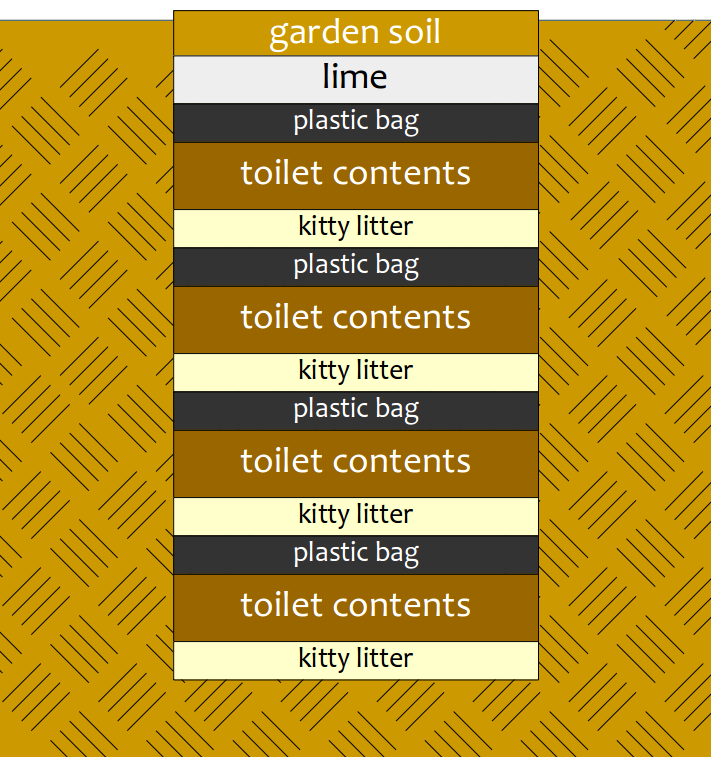
Animals will spread feces around along with disease. You must keep them out of it.
Use large trash cans with a tight-fitting lids and bags that fit and seal well. Allow to freeze, then bury properly as noted above as soon possible (when ground thaws).
Do not store disposable feminine needs or baby diapers for disasters. These are hard to dispose of safely and begin quickly to contribute to sanitation disasters. Instead, research and stock up on "old-way" solutions for women's monthly needs and on cloth baby diapers.
In a low-technology environment including loss of water pressure or, even when water abounds, a loss of electricty, the good, old stand-by, our city septic systems—and even the nigh totality of private septic systems—become inoperable.
If you're thinking hard about this, you quickly realize that plumbing p-traps will dry out (especially in the low-humidity Western United States). You might think this is just a matter of dedicating some of your water to keeping those p-traps filled, but remember, this is a huge community problem.
Disasters that can contribute to the total or partial loss of sanitation facilities include earthquake, civil unrest or even merely loss of power for more than a few hours.
Moreover, it's not safe to put anything down a sewer system that's no longer functioning. You may be creating a problem for your own home; at best, however, you're just pushing what problem that creates down the line and hurting someone else.
The two problems associated with losing control of the sewer system are
Hydrogen sulfide is a strong irritant and not merely a nasty smell. It can cause skin and eye irritation and even disease after sufficient exposure. Left unsolved, the concentration of H2S will quickly lead to a serious danger to health in the home, not only because of unpleasant smells and disease, but the very real danger of explosion because the gas is flammable.
Vermin to be feared include
These will crawl up your drain pipes and merely keeping water in the p-traps will not prevent them from gaining access to your home.
All drains are direct connections to the sewer system. You'll find these at
All of these must be plugged when the sewers are down for more than a few hours.
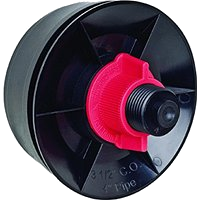
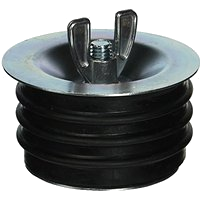
Drains are of different sizes and you'll have to purchase special plugs for this. On Amazon today, I found plugs of all sizes for anywhere from $5 to $15. I used "test plug" as my search string.



Toilets aren't so easily plugged.
Likely, you'll want to be turning one or more of your toilets into "dry potties." Here's how this is done (including how this direct connection to the sewer system is plugged):

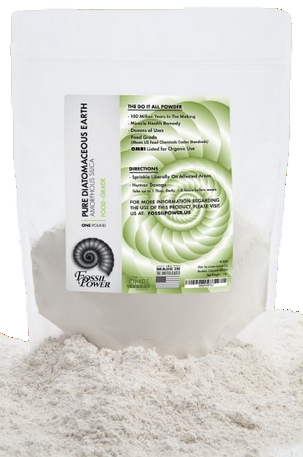

This is an underrated product, part of the "old ways" that people used to know about. Diatomaceous earth is basically ground up, fossilized sea shells, a fine powder. It is toxic to insects because it interferes physically with their exoskeleton bodies, but it is not the least bit toxic to humans and other mammals.
Diatomaceous earth can be consumed by humans safely. It acts as a vermicide or deworming agent. It also has other, less officially accepted properties, for instance, it's been observed that it reduces edema or swelling.
It's available, sometimes from IFA, always from Amazon. Recently, 5lb and 10lb bags were selling for $20. Ensure you purchase only "food-grade."
Once useful way to store water for washing is to purchase liquid laundry detergent in sturdy plastic bottles. When used up, fill the bottle, which has a bit of detergent left inside, with water and find a place to keep it. It can be used to launder and perform sanitizing duties when needed.